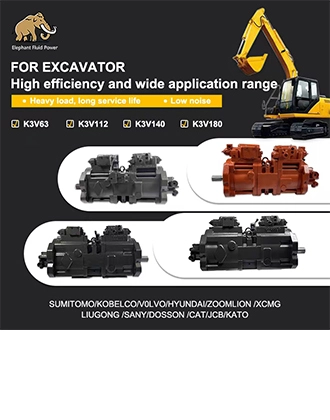First, Definition and function of the main pump for excavators
1. Definition: The main pump of the excavator is the core component of the hydraulic system of the excavator, which is responsible for converting mechanical energy into hydraulic energy and providing power for various actions of the excavator.
2. Function: The main pump of the excavator sucks in the hydraulic oil and transports it to the various hydraulic actuators of the excavator (such as hydraulic cylinders, hydraulic motors, etc.) after pressurization, so as to drive the bucket, boom, track and other parts of the excavator to carry out various actions.
1. Type: There are various types of excavator main pumps, which can be divided into gear pumps, piston pumps, piston pumps, etc. according to the different structures and working principles. Among them, the piston pump has been widely used in excavators because of its high pressure and large flow characteristics.
2. Structure: The main pump of the excavator is usually composed of the pump body, plunger (or piston), oil distribution pan, transmission shaft and other components. The pump body is the main part of the main pump, and the plunger (or piston) reciprocates in the pump body, and realizes oil suction and oil discharge by changing the volume of the pump chamber. The distribution pan distributes the suction fluid to the individual hydraulic actuators and directs the return oil back to the tank.
Third, the working principle of the main pump of the excavator
1. Working principle: The working principle of the main pump of the excavator is based on the working principle of the positive displacement pump. When the propeller shaft drives the plunger (or piston) to reciprocate in the pump body, the volume of the pump chamber changes. When the plunger (or piston) moves backwards, the volume of the pump chamber increases, forming negative pressure, which sucks in the hydraulic oil; When the plunger (or piston) moves forward, the volume of the pump chamber decreases, and the hydraulic oil is pressurized and discharged. By constantly changing the volume of the pump chamber, the main pump of the excavator can achieve a continuous oil supply.
2. Control of flow and pressure: The flow and pressure of the main pump of the excavator can be controlled by adjusting the stroke of the plunger (or piston) and changing the speed of the transmission shaft. In practice, excavator main pumps are often used in conjunction with other components in the hydraulic system, such as relief valves, throttle valves, etc., to achieve more accurate flow and pressure control.
Fourth, maintenance and troubleshooting of excavator main pump
1. Maintenance: The maintenance of the main pump of the excavator mainly includes regular replacement of hydraulic oil, cleaning of the pump body and oil distribution pan, and checking the wear of the plunger (or piston) and transmission shaft. Regular replacement of hydraulic oil can maintain the cleanliness of the hydraulic oil and reduce the wear of the pump body; Cleaning the pump body and oil distribution pan can remove the impurities and dirt deposited in the pump body and keep the pump body working normally; Checking the wear of the plunger (or piston) and the drive shaft can detect and replace the severely worn parts in time to prevent the occurrence of failures.
2. Fault handling: The common faults of the main pump of the excavator include leakage of the pump body, insufficient pressure, insufficient flow, etc. When there is a failure, the cleanliness and viscosity of the hydraulic oil should be checked first, then the pump body and oil distribution pan should be checked for wear or damage, and finally the plunger (or piston) and transmission shaft should be checked to see if they are working normally. Based on the results of the inspection, the fault can be rectified by corresponding repairs or replacement of parts.
Main hydraulic pump diagram
Excavator hydraulic pump types
 French
French
 Portuguese
Portuguese
 Russian
Russian
 German
German
 Spanish
Spanish
 Japanese
Japanese
 Korean
Korean
 Irish
Irish
 Greek
Greek
 Turkish
Turkish
 Italian
Italian
 Danish
Danish
 Romanian
Romanian
 Indonesian
Indonesian
 Czech
Czech
 Afrikaans
Afrikaans
 Swedish
Swedish
 Polish
Polish
 Basque
Basque
 Catalan
Catalan
 Esperanto
Esperanto
 Hindi
Hindi
 Lao
Lao
 Albanian
Albanian
 Amharic
Amharic
 Armenian
Armenian
 Azerbaijani
Azerbaijani
 Belarusian
Belarusian
 Bengali
Bengali
 Bosnian
Bosnian
 Bulgarian
Bulgarian
 Cebuano
Cebuano
 Chichewa
Chichewa
 Corsican
Corsican
 Croatian
Croatian
 Dutch
Dutch
 Estonian
Estonian
 Filipino
Filipino
 Finnish
Finnish
 Frisian
Frisian
 Galician
Galician
 Georgian
Georgian
 Gujarati
Gujarati
 Haitian
Haitian
 Hausa
Hausa
 Hawaiian
Hawaiian
 Hebrew
Hebrew
 Hmong
Hmong
 Hungarian
Hungarian
 Icelandic
Icelandic
 Igbo
Igbo
 Javanese
Javanese
 Kannada
Kannada
 Kazakh
Kazakh
 Khmer
Khmer
 Kurdish
Kurdish
 Kyrgyz
Kyrgyz
 Latin
Latin
 Latvian
Latvian
 Lithuanian
Lithuanian
 Luxembourg
Luxembourg
 Macedoniar
Macedoniar
 Malagasy
Malagasy
 Malay
Malay
 Malayalam
Malayalam
 Maltese
Maltese
 Maori
Maori
 Marathi
Marathi
 Mongolian
Mongolian
 Burmese
Burmese
 Nepali
Nepali
 Norwegian
Norwegian
 Pashto
Pashto
 Persian
Persian
 Punjabi
Punjabi
 Serbian
Serbian
 Sesotho
Sesotho
 Sinhala
Sinhala
 Slovak
Slovak
 Slovenian
Slovenian
 Somali
Somali
 Samoan
Samoan
 Scots Gaelic
Scots Gaelic
 Shona
Shona
 Sindhi
Sindhi
 Sundanese
Sundanese
 Swahili
Swahili
 Tajik
Tajik
 Tamil
Tamil
 Telugu
Telugu
 Thai
Thai
 Ukrainian
Ukrainian
 Urdu
Urdu
 Uzbek
Uzbek
 Vietnamese
Vietnamese
 Welsh
Welsh
 Xhosa
Xhosa
 Yiddish
Yiddish
 Yoruba
Yoruba
 Zulu
Zulu







